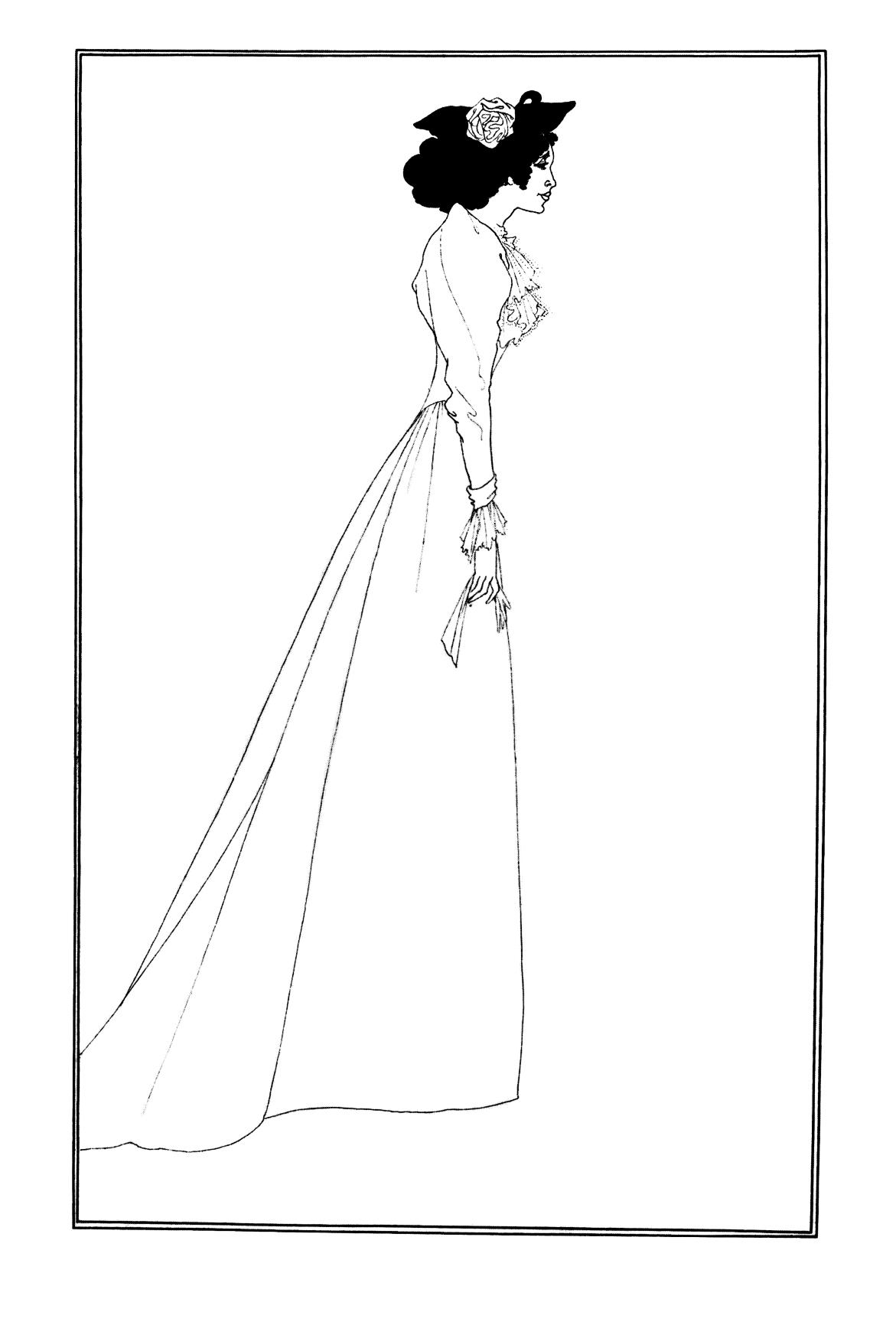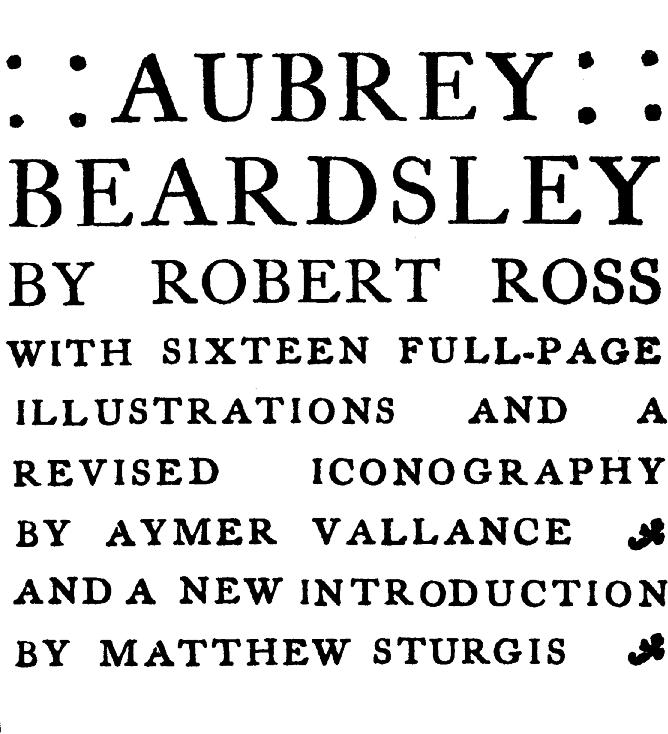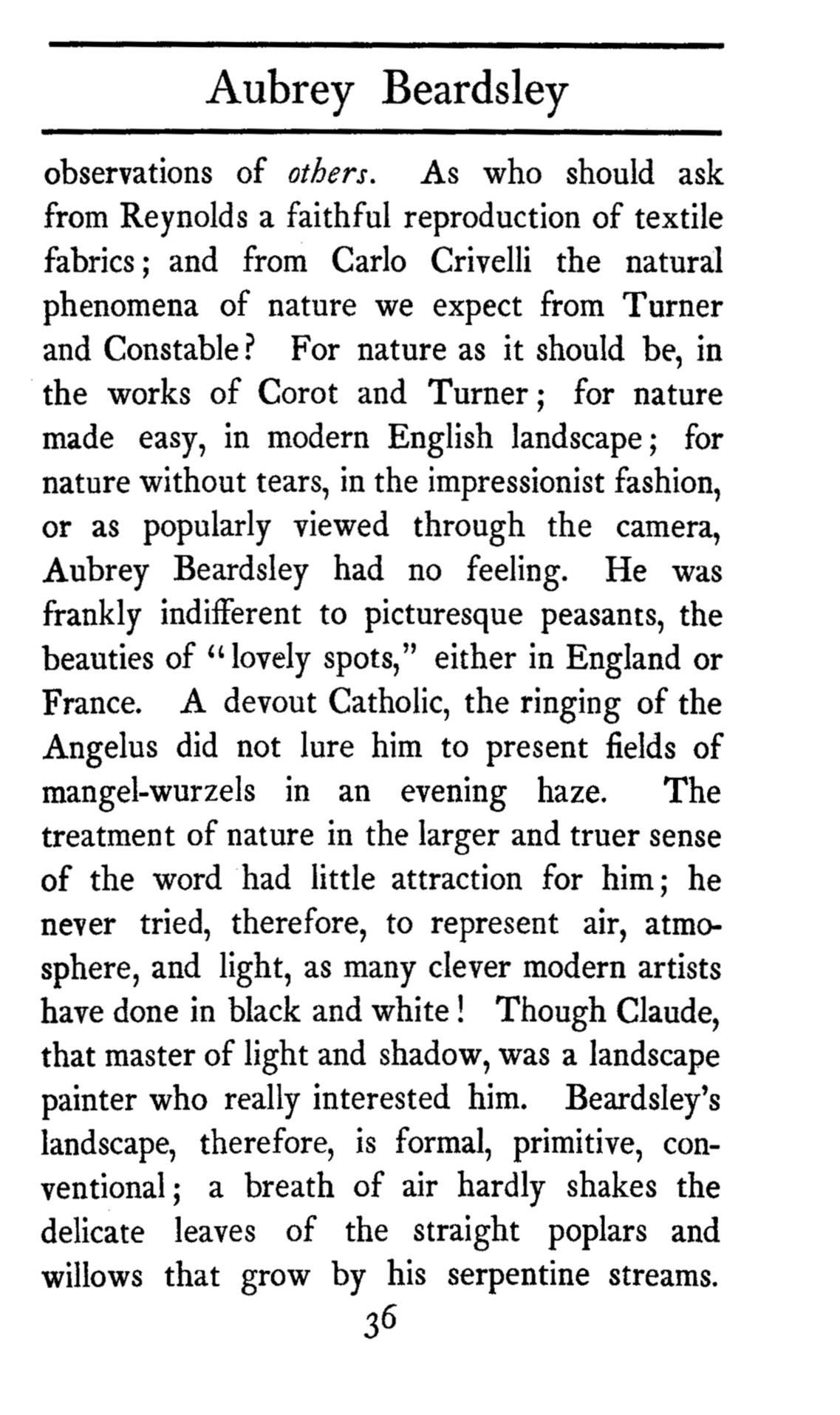INTRODUCTION
BY MAT THEW STURGIS
Aubrey Beardsley died at Menton in the early hours of 16 March 1898, at the age of just twenty-five. Since childhood he had suffered from tuberculosis, and the illness had advanced rapidly during the last years of his life. He had travelled to the French Riviera in a last, doomed, bid to sustain his failing health.
Despite the incapacitating effects of regular haemorrhages and collapses, he had managed to produce an extraordinar y body of work in just seven years of professional life, and to gain an equally extraordinar y reputation. He was acknowledged in Britain, on the Continent, and even in America to be both a master of black-and-white art and t h e
1 8 9 0 s. He ha
the illustrations for Oscar Wilde’s Salome and Malor y ’ s Mor te Dar thur, the front covers for the Yel low Book, the decorations for an exquisite edition of The Rape of the Lock, and a set of arrestingly frank drawings for a clandestine volume of Aristophanes ’ Lysistrata. At
I N T RO D U C T I O N
project, an edition of Ben Jonson’s Volpone. Only seven of the proposed twenty-four pictures had been completed:
‘ a marked departure’, as he called it, from all his previous s t y l e s. B
L
n a rd Smithers (who had already advanced money for the illustrations) determined to produce the book even with these limited ing redients.
The handsomely got-up volume (produced in an edition of one thousand copies, with an extra hundred printed o n Ja p a n e
)
De
m b
1 8 9 8 . To bulk out the material, Smithers had commissioned a critical essay on Ben Jonson from Vincent O’Sullivan, and a ‘ E u l o g y o f t h e a r t i s t ’ f r o m Ro b e r t Ro s s. Ro s s ’ s e s s a y –minimally edited – was issued as a separate book in 1909 by John L ane, and it is re-issued again here.
Robert Ross is now remembered (if he is remembered at all) as the friend and literar y executor of Oscar Wilde; t h e g o o d a n g e l w h
t
d h i m i n t h e ye a r s o f e x i l e after his release from prison, who was with him at the end, and who – by careful literar y husbandr y – eventually g o t h i s e s t a t e o u t o f ba n k r u p t c y. ( T h i s l a s t f e a t w a s achieved largely, it seems, through the royalties received viii
M
i
G e
m a n y and Austria in the early years of the new centur y)
In 1898, though, Ross was a young man of twentyn i n e, m
B o r n i n 1 8 6 9 , t o t h
At
C a n a d a, h e ha d c o m e t o E n g l a n d j u s t b e f o r e h i s s e c o n d birthday, following his father ’ s death. A delicate youngest child, with a doting mother, he had been tutored at home before being sent to Cambridge. The experience was not a happy one and he soon fled back to L ondon to continue h i s e d u ca t i o n a t a c ra m m e r ’ s. Ro s s ha d l o n g r e c
i
e d and accepted his own homosexuality, but at some moment during 1886 he met Oscar Wilde (then a happily-married father of two), and seduced him – initiating a new phase in Wilde’s life. Their affair soon transformed into a friendship, but it was a close and enduring one. ( Ross had many gifts, but perhaps his g reatest was the gift for friendship.)
Wi l d e e n
began contributing reviews and short-stories to periodica l s, a
, house jour nal of the Society of Authors. But it was the visual arts that held the deepest interest for him. He was attracted to the company of artists and art-lovers.
I N T RO D U C T I O N
In his ‘Eulog y ’ Ross gives a vivid account of how he f i r s t e n c o u n t e r e d Au b r e y B e a rd s l e y, o n 1 4 Fe b r u a r y
1892, at the flat of his friend Aymer Vallance, a writer on the decorative arts. At that time Beardsley was an unknown and unpublished nineteen-year-old. Ross ’ s claims that he at once recog nized the genius of the strange boy do not, however, seem to be an invention of hindsight.
From the moment of that first meeting he busied himself to promote and support the would-be artist, introducing him to useful contacts and arranging sales of his work. He e v e n p u r c ha s e d s e v e ra l p i e c e s h i m s e l f. O f t h e w o r k s listed in the ‘Iconog raphy’ that Vallance contributed to the 1909 edition of Ross ’ s ‘Eulog y ’ , six drawing are marked as belonging, or having belonged to, ‘Robert Ross, Esq.’ T h e r e w e r e p l a n s t o c o l l a b o ra t e o n a p r o j e c t ca l l e d
Ma s q u e s , f o r w h i c h B e a rd s
h
p e d t ha t Ro s s w o u l d provide ‘ some occasional verse ’ and ‘ a prologue to be spoken by Pierrot ’ . Nothing, however, came of it.
It was Ross, almost certainly, though, who – in March 1893 – introduced to Beardsley to Oscar Wilde. It was to prove fr uitful and fateful association. Wilde was then f l u s h e d w i t h n o t o r i e t y – i f n o t q u i t e s u c c e s s – a f t e r h i s French symbolist drama had been denied a per formance licence by the L ord Chancellor on the g rounds that it was
M AT T H E W S T U RG I S
L ondon stage.
Beardsley hitched a lift on this thermal of publicity when he secured the commission to illustrate the English edition of Wilde’s play. His pictures – stark asymmetric
The book seemed to define a new era of artistic daring and experiment. Although Wilde was the established figure, many considered that Beardsley’s drawing over whelmed the play-text. Wilde himself complained of the drawings, ‘they are too Japanese while my play is Byzantine.’
Relations between the two men, though friendly, were always fraught with a mixture of rivalr y and wit. Wilde described Beardsley as having a face ‘like a silver hatchet ’ ; Beardsley inserted sly caricatures of Wilde into his work.
The situation, however, became rather more difficult at the time of Oscar Wilde’s spectacular fall from g race in 1895, when he found himself in the dock charged with c o m m i
men.
This was a period of crisis. For Wilde, of course, it was a personal tragedy. But for the whole artistic community it marked an epoch. There was a sudden shift in mood. All the artistic experiments and innovations of the moment
I N T RO D U C T I O N
became ‘lumped ’ together – as the phrase had it – as part o f a g e n e ra l ‘Os ca r Wi l d e ’ t e n d e n c y. Re a l i s m , Im p r e s -
s i o n i s m , Ib s e n i s m , Z o l a - i s m , Sy m b
Decadence with which Wilde and Beardsley were most closely associated, were all roundly condemned in the press and from the pulpit. There was a pronounced reaction, a retur n to conventional styles and uplifting subjects. And Beardsley suffered from this reaction more than any other figure.
T h e c l o s e c o n n e c t i o n b e t w e e n Wi l d e a n d B e a rd s l e y that had been established in the public mind at the time of the Salomé illustrations, ensured that Beardsley’s name w a s b l a c
. Al t h
h h e w a s n o t a h o m o s e x u a l, h i s d ra w i n g s w e r e c o n s i d e r e d t o d i s p l a y a m a r k e d s e x u a l d e p ra v i t y. He w a s s e e n a s t h e e m b o d iment of ‘the Oscar Wilde tendency’ in art. Many erstwhile allies hastened to distance themselves from him. After a petition by ner vous colleagues Beardsley lost his job as arteditor of the Yel low Book, and with it the income that had sustained him, as well as his mother and sister. It was a devastating blow – to his pride, to his good name, to his finances, to his professional prospects. He recog nized that it was not Wilde’s fault, but this did little to detract from the g ravity of his predicament. xii
M AT T H E W S T U RG I S
p ra c t i ca l
patron Marc-André Raffalovich. Raffalovich cordially disliked Wilde, and the ultimatum, ‘ You cannot be Oscar ’ s
f r i e n d a n d m i
Beardsley, when confronted on this point, per force chose h i s n e w b e n e fa c
a l break with Wilde, but there was unmistakeable shift of allegiance.
When Wilde was released from prison, after ser ving t w o ye a r s w i t h ha rd l a b o u r, B e a rd s l e y, d e s p e ra t e l y i l l, had already begun his sad wanderings among the healthresorts of England and France. Both men did find them-
s e l v e s s t a yi n g a t D i e p p e i n t h e s u m m e r o f 1 8 9 7 , a n d
a l t h o u g h B e a rd s l e y g r e e t e d h i s o l d f r i e n d w a r m l y, h e contrived to keep him at a distance.
Ross as the intimate of both Wilde and Beardsley was in a potentially awkward position between the two. He w a s, t h o u g h, a n a d e p t a t d e a l i n g w i t h s u c h d e l i ca t e
s i t u a t i o n s, a n d r e t a i n e d t h e t r u s t – a n d t h e a f f e c t i o n –
o f a l l p a r t i e s. He a s s i s t e d B e a rd s l e y w i t h h i s h o u s e -
m o v e s a n d v i s i t e d h i m a t t h e v a r i o u s c o u n t r y r e t r e a t s
t o w h i c h h e ha d f l e d t o i n s e a r c h o f c l e a n a i r a n d a
‘ b ra c i n g ’ c l i m a t e. As a f e l l o w c o n v e r t h e w e l c o m e d xiii





